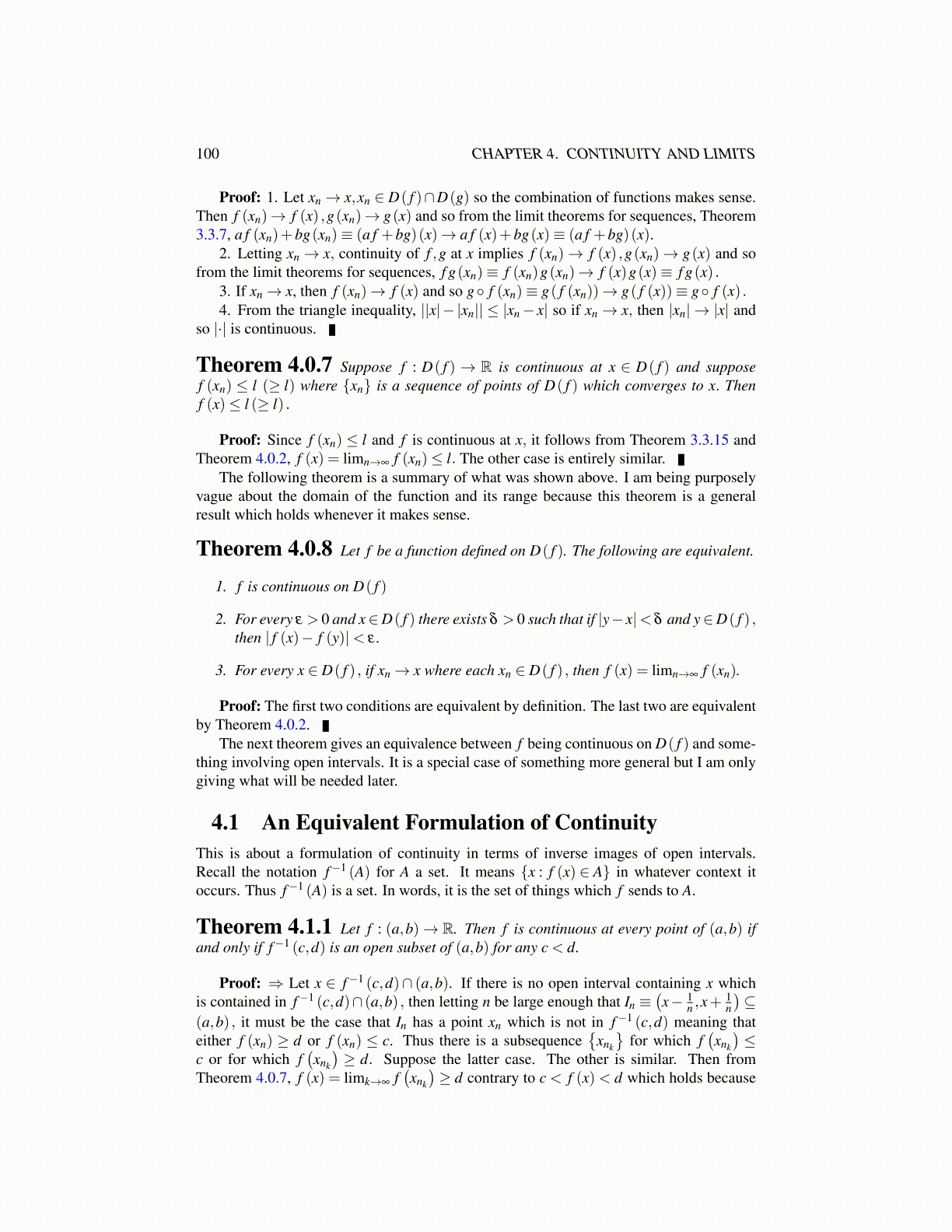
100 CHAPTER 4. CONTINUITY AND LIMITS
Proof: 1. Let xn → x,xn ∈ D( f )∩D(g) so the combination of functions makes sense.Then f (xn)→ f (x) ,g(xn)→ g(x) and so from the limit theorems for sequences, Theorem3.3.7, a f (xn)+bg(xn)≡ (a f +bg)(x)→ a f (x)+bg(x)≡ (a f +bg)(x).
2. Letting xn → x, continuity of f ,g at x implies f (xn)→ f (x) ,g(xn)→ g(x) and sofrom the limit theorems for sequences, f g(xn)≡ f (xn)g(xn)→ f (x)g(x)≡ f g(x) .
3. If xn → x, then f (xn)→ f (x) and so g◦ f (xn)≡ g( f (xn))→ g( f (x))≡ g◦ f (x) .4. From the triangle inequality, ||x|− |xn|| ≤ |xn − x| so if xn → x, then |xn| → |x| and
so |·| is continuous.
Theorem 4.0.7 Suppose f : D( f ) → R is continuous at x ∈ D( f ) and supposef (xn) ≤ l (≥ l) where {xn} is a sequence of points of D( f ) which converges to x. Thenf (x)≤ l (≥ l) .
Proof: Since f (xn) ≤ l and f is continuous at x, it follows from Theorem 3.3.15 andTheorem 4.0.2, f (x) = limn→∞ f (xn)≤ l. The other case is entirely similar.
The following theorem is a summary of what was shown above. I am being purposelyvague about the domain of the function and its range because this theorem is a generalresult which holds whenever it makes sense.
Theorem 4.0.8 Let f be a function defined on D( f ). The following are equivalent.
1. f is continuous on D( f )
2. For every ε > 0 and x∈D( f ) there exists δ > 0 such that if |y− x|< δ and y∈D( f ) ,then | f (x)− f (y)|< ε .
3. For every x ∈ D( f ) , if xn → x where each xn ∈ D( f ) , then f (x) = limn→∞ f (xn).
Proof: The first two conditions are equivalent by definition. The last two are equivalentby Theorem 4.0.2.
The next theorem gives an equivalence between f being continuous on D( f ) and some-thing involving open intervals. It is a special case of something more general but I am onlygiving what will be needed later.
4.1 An Equivalent Formulation of ContinuityThis is about a formulation of continuity in terms of inverse images of open intervals.Recall the notation f−1 (A) for A a set. It means {x : f (x) ∈ A} in whatever context itoccurs. Thus f−1 (A) is a set. In words, it is the set of things which f sends to A.
Theorem 4.1.1 Let f : (a,b)→ R. Then f is continuous at every point of (a,b) ifand only if f−1 (c,d) is an open subset of (a,b) for any c < d.
Proof: ⇒ Let x ∈ f−1 (c,d)∩ (a,b). If there is no open interval containing x whichis contained in f−1 (c,d)∩ (a,b) , then letting n be large enough that In ≡
(x− 1
n ,x+1n
)⊆
(a,b) , it must be the case that In has a point xn which is not in f−1 (c,d) meaning thateither f (xn) ≥ d or f (xn) ≤ c. Thus there is a subsequence
{xnk
}for which f
(xnk
)≤
c or for which f(xnk
)≥ d. Suppose the latter case. The other is similar. Then from
Theorem 4.0.7, f (x) = limk→∞ f(xnk
)≥ d contrary to c < f (x)< d which holds because